Old Testament Survey
The Ark and the Tabernacle

The Ark of the Covenant is the throne of God on earth. It is a symbol of God’s power. Indeed, ultimately, during Samuel’s time, the people treated the Ark as a superstitious token of God’s power. While we do not have time to travel down a side road for an in-depth look at the Tabernacle and its furnishings, a brief consideration seems in order.
Hebrews 9:2-5
2 For there was a tabernacle made; the first,
wherein was the candlestick, and the table, and the shewbread;
which is called the sanctuary. 3 And after the second veil, the
tabernacle which is called the Holiest of all; 4 Which had the
golden censer, and the ark of the covenant overlaid round about
with gold, wherein was the golden pot that had manna, and Aaron’s
rod that budded, and the tables of the covenant; 5 And over it
the cherubims of glory shadowing the mercyseat; of which we cannot
now speak particularly.
Hebrews 8:5
Who serve unto the example and shadow of
heavenly things, as Moses was admonished of God when he was about
to make the tabernacle: for, See, saith he, that thou make all
things according to the pattern shewed to thee in the mount.
In Hebrews 8:5, the word translated pattern comes from the Greek word tupos, meaning an example to be imitated. It is from this Greek word which theologians have developed the concept of a “type.” A type is a person or thing prefiguring a future (Messianic) person or thing. Thus, the Tabernacle and its furnishings are “types” or prefigurements or examples of things to come.
Let us look briefly then at the Tabernacle and its furnishings to find the Messianic types.
At the time the Tabernacle was constructed, the Nation of Israel had every reason to believe they would shortly be in the Promised Land and would shortly be worshiping God there. Solomon would later build a Temple for God in Jerusalem and the furnishings of the Tabernacle would be moved to the Temple. It was the veil of the Temple which separated the Holy of Holies from the Holy Place or Sanctuary which was rent in two at the Crucifixion of Christ.

The Tabernacle’s center tent held the Holy Place and the Holy of Holies. There was a courtyard in front of the Tent which held the Brazen Laver and the Brazen Altar. This is the altar for burnt offerings. The entire structure and courtyard was surrounded by a fence through which there was only one entrance. When the Temple was constructed, and then rebuilt by Herod, this single courtyard had expanded into a series of courtyards, including the Courtyard of the Gentiles and the Courtyard of Women. Each served as a barrier to prevent certain groups from proceeding inward toward the Temple proper. The shops and moneychangers which Jesus attacked both at the commencement (John 2) and end of His ministry were located in the Courtyard of the Gentiles. While not part of the original pattern, Christ still considered these courtyards to be part of God’s House since they were part of the physical structure.
As with parables, it is somewhat difficult to decide how to, and when to, interpret types. Clearly, all of Scripture points to Christ and in this sense virtually all of the Bible is a type. But at a more specific level, there is some danger in viewing items in too great of detail. For this reason, many evangelical scholars prefer not to consider anything a type unless it is specifically addressed as such in Scripture. For example, Peter treats the flood as a type of baptism (1 Peter 3:20-21). On the other hand, this may be too restrictive.
As far as the Tabernacle is concerned, studies exist which treat all of the construction materials and colors as types. While this may be correct, it is beyond the scope of this short study to consider such detail. Further, some of the conclusions which are arrived at in such an approach, for example as to colors, may be contradicted or changed in other parts of Scripture. If you are interested in this area, several studies are listed in the bibliography and you are urged to undertake your own study. This study will restrict itself to the Tabernacle proper and its main furnishings.
Moses was directed to build a series of furnishings for the Tabernacle. The Tabernacle or Tent of the Meeting became the location of many of God’s conversations with Moses. The Levites were taken by God as His tithe of the people and given the task of caring for the Tabernacle. Part of the items constructed, for example, was a carrying case for the Tent. Specific instructions were given as to how items could be handled – and by whom. The Ark, for instance, could not be touched. It was carried by Levites using special poles.
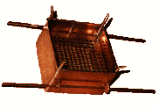
As one enters the outer gate, one comes upon the Brazen Altar. This is the altar of the burnt offerings (Exod 27:1-8; 38:1-7). All sacrifices were offered here, but only by the priests. This, then, becomes the Cross, the point of the only true sacrifice. To the extent that the details may represent parts of the type, the only important point to remember is that God established the rules and determined the timing. He chose Jesus as the only true, perfect sacrifice for us. It is upon the altar that sacrifices were offered by the people for or as a substitute for the sins of the people. Jesus became our substitute:
Mark 10:45
For even the Son of man came not to be ministered
unto, but to minister, and to give his life a ransom for many.
This control of God is reflected in the teachings of Christ. In the Sermon on the Mount, Jesus reflects that wide is the road that leads to destruction, but narrow is the road that leads to salvation. There is but one entrance gate into the courtyard. There is only one way to reach the altar where sins may be forgiven.:
John 10:9; 14:6
Jesus saith unto him, I am the way, the
truth, and the life: no man cometh unto the Father, but by me.
. . I am the door: by me if any man enter in, he shall be saved,
and shall go in and out, and find pasture.
Next, across the courtyard from the Brazen Altar, sitting just in front of the entrance to the Holy Place, is the Brazen Laver (Exod 30:17-21; 38:8). Here the priest cleansed themselves before entering into the Holy Place. It is the Word of God and the blood of Christ which cleanses men from their sins. Jesus told His disciples at the Last Supper,
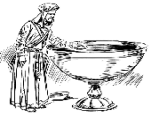
John 13:8
Jesus answered him, If I wash thee not,
thou hast no part with me.
I am that bread of life.
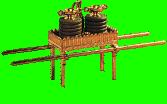
One then enters into the Holy Place. On the right, as one enters the Holy Place, sits the Table for the Shewbread (Exod 25:23-29; 37:10-16). Made of wood, this table represents the flesh of Christ, while the gold overlay represents His Deity. This combination of wood and gold is present in many of the furnishings and represents this perfect union of Christ. Upon the Table sat twelve loaves of shewbread, or the bread of the presence. Made without leaven(yeast), these breads are baked from only fine floor. Leaven represents sin in the Scriptures, so these loaves are representative of sinless perfection, a sinlessness which provides nourishment and sustains us.

John
8:12
Then spake Jesus again unto them, saying,
I am the light of the world: he that followeth me shall not
walk in darkness, but shall have the light of life.
Opposite the Table of the Shewbread is the Golden Lamp Stand (Exod 25:31-39; 37:17-24). These lamps burned continually shedding light upon God’s House (Exod 27:20). It is interesting to note that oil may be viewed as a picture of the Holy Spirit, the power behind our light in Christ. But it is Jesus Christ Himself who is the light:
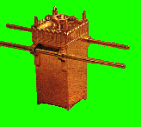
Sitting in front of the veil which separates the Holy Place from the Holy of Holies is the Golden Altar of Incense (Edox 30:1-10; 37:25-28). If the veil did not exist, the Altar of Incense would sit directly in front of the Ark of the Covenant and the Mercy Seat. The Incense being offered continually by the priests represents the intercession necessary before God. The aroma of the burning incense represents the prayers of the people. Christ as our prime mediator and intercessor offers His prayers for us.
John 17:9
I pray for them: I pray not for the world,
but for them which thou hast given me; for they are thine.

The Veil separated the Holy Place from the Most Holy Place, the Holy of Holies (Exod 26:31-33; 36:35-36). Scripture teaches that sin has clearly separated man from God. The veil represents this separation. God resides behind the veil in the Most Holy Place. The priest could not enter, except for the High Priest. And he could enter only on the Day of Atonement, a once a year event! The writer of Hebrews tells us Jesus’ flesh is this veil. With the Cross, the flesh was given and the veil was torn opening a new path to God.
By a new and living way, which he hath consecrated for us, through the veil, that is to say, his flesh.
Hebrews 10:20
Jesus is our intercessor because as God
He has access to God continually, sitting at the right hand of
the Father.
Hebrews 6:19,20
19 Which hope we have as an anchor of the
soul, both sure and stedfast, and which entereth into that within
the veil; 20 Whither the forerunner is for us entered, even Jesus,
made an high priest for ever after the order of Melchisedec.
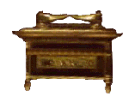
Entering through the veil into the Holy of Holies one comes upon the Ark of the Covenant (Exod 25:10-16; 37:1-5). As has been emphasized in our study of First Samuel, the Ark represents the seat of God’s presence with the Israelites. Covering the Ark was the Mercy Seat. This gold covering was adorned by two Cherubim (Exod 25:17-22; 37:6-9). It was at the Mercy Seat where God met with Moses (Exod 25:22).
The Mercy Seat typifies Christ, the location where “Mercy and truth are met together; righteousness and peace have kissed each other” (Psalm 85:10). The Mercy Seat represents the Purpose of Christ, the forgiveness and reconciliation of the God and man. The Ark, on the other hand, represents the Person of Christ, the combination of human (wood) and divine (gold). The Ark is the vessel of all that Christ represents.
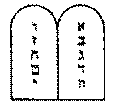
Hebrews
9:4
And the ark of the covenant overlaid round
about with gold, wherein was the golden pot that had manna,
and Aaron’s rod that budded, and the tables of the covenant.
First there is the manna, the bread from heaven, the bread of life is Jesus, the true life which came down out of heaven (John 6:32-35, 48-58). “And this is life eternal, that they might know thee the only true God, and Jesus Christ, whom thou hast sent” (John 17:3). Then there are the Tables of the Covenant, the Ten Commandments, the Law which Christ came to fulfill. The Law is kept in the Ark, just as God’s law is to be kept in our hearts. “I delight to do thy will, O my God: yea, thy law is within my heart” (Psalm 40:8). Finally, Aaron’s rod that budded is in the Ark, for it is only in Christ that one may find life. And this life is life out of death!
John 14:19; 11:25,26.
“19 Yet a little while, and the world
seeth me no more; but ye see me: because I live, ye shall live
also. . . 25 Jesus said unto her, I am the resurrection, and the
life: he that believeth in me, though he were dead, yet shall
he live: 26 And whosoever liveth and believeth in me shall never
die. Believest thou this?”
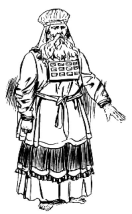
Once a year, the High Priest entered into the Holy of Holies and sprinkled blood on the Mercy Seat (Lev 16:1-34; 23:26-32; Hebrews 9:7). In this Christ is the final sacrifice, the final offering for our sins, the final blood offering.
1 John 2:2
And he is the propitiation [atonement,
expiation, ultimate sacrifice] for our sins: and not for
ours only, but also for the sins of the whole world.
Christ is also our High Priest.
Hebrews 9:11
But Christ being come an high priest of
good things to come, by a greater and more perfect tabernacle,
not made with hands, that is to say, not of this building.
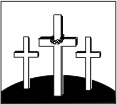
The Tabernacle in total then is a pattern of Christ and of the things to come. It represents the proper method of worship before God. The teachings of the Old Testament demonstrated there was only one way to approach God. These were the rules God had set forth. Since Christ is the fulfillment of the picture of the Tabernacle, it is clear that He is now the only way to approach God. This is the clear teaching of both Jesus and the New Testament.
Even as the furnishings of the Tabernacle passed away, so did the Tabernacle constructed by Moses in the wilderness. The Ark had many homes between the wilderness and the Temple. In deed, God says:
1 Chronicles 17:4-5
4 Go and tell David my servant, Thus saith
the LORD, Thou shalt not build me an house to dwell in: 5 For
I have not dwelt in an house since the day that I brought up Israel
unto this day; but have gone from tent to tent, and from one tabernacle
to another.
Christ is permanent, forever, the First and the Last, the same yesterday, today, and tomorrow. He cannot pass away. He will always be there for us.
Two other pictures or observations may be made about the Tabernacle and its furnishings. First, when one reads Exodus, the order of construction given to Moses starts with the Ark and works its way out. God reaches out to man first! Man, on the other hand, when he walks into the Tabernacle must work his way back to God. God reached out to mankind through Jesus so that mankind would have a means of getting back to God!
Lastly, turn the page and notice once again the arrangement of the furnishings. Try playing connect the dots. First draw a line from the Ark to the Brazen Altar. Now, draw a line from the Golden Candlestick to the Table of the Shewbread. Does it look at all familiar?
The photographs of the Brazen Altar, the Table of the Presence or Shewbread, the Altar of Incense, and the Veil come from Geneva Tabernacle Model, www.domini.org/tabern/geneva.htm, and are used with permission of the copyright holder.
